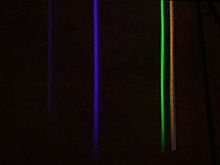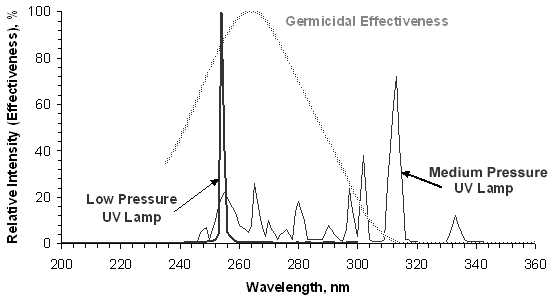The emission of low pressure mercury lamps exhibits a characteristic optical spectrum with pronounced spectral lines mostly in the visible and the ultraviolet spectral region but partly also in the infrared.
Low pressure mercury lamp emission spectrum.
Uv led 365 385 395 405nm spectrums compared with spectrum of uv mercury traditional lamp.
The power density and the radiance of the emitted light are relatively low.
Often called germicidal or ozone absorption lamps they are very stable light sources.
Line spectrum of mercury vapor.
Lp lamps operate at about 40 c and have one useful disinfection output peak at 254nm.
The strongest peaks of the emission line spectrum are in low pressure mercury vapor lamps only the lines at 184 nm and 253 nm are present.
The blue green tint of mercury vapor lamps is caused by the strong violet and green lines.
Fused silica is used in the manufacturing to keep the 184 nm light from being absorbed.
Low pressure mercury vapor lamps are a highly efficient source of uv light particularly short wavelength uv light 254nm and 185nm.
Sodium vapor low pressure bright orange yellow.
The visible spectrum is not very spectacular.
Strong emissions occur in the 350 380 nm region at which typical uv photoinitiators absorb.
These types of lamps are available in ozone producing and ozone free quartz with a variety of phosphors.
In low pressure mercury vapor lamps only the lines at 184 nm and 254 nm are present.
Widely used in mercury vapor lamps.
In medium pressure mercury vapor lamps the lines from 200 600 nm are present.
Aquafine lp lamps are considered to be monochromatic or single peak output lamps.
Low pressure mercury lamps emit sharp bands primarily at 185 and 254 nm.
The five well known emission lines of mercury hg at 405 436 546 577 and 579 nm are clearly visible.
Rather than a cold spot the lamp s amalgam spot on pellet regulates mercury vapor pressure during operation and yields up to three times the uvc output of a standard low pressure mercury lamp of the same length.
Facts about aquafine standard low pressure lp lamps.
Due to this characteristic emission spectrum these lamps are not suitable for laboratory photo oxidation studies klan and wirz 2009.
Amalgam lamps use a mercury amalgam mix to control mercury vapor pressure.
The latter two yellow lines not resolved by.
There is not emission in the ranges uv b and uv c and also in the visible spectrum the emission is minimum.










